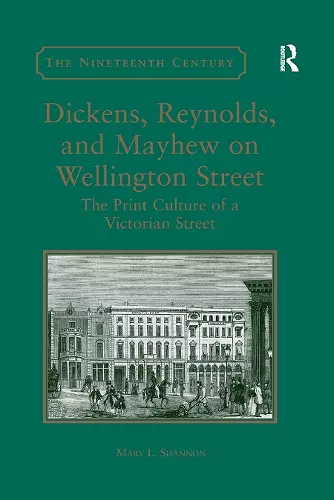Dickens, Reynolds, and Mayhew on Wellington Street
The Print Culture of a Victorian Street
Format:Paperback
Publisher:Taylor & Francis Ltd
Published:12th Dec '19
Currently unavailable, and unfortunately no date known when it will be back
This paperback is available in another edition too:
- Hardback£145.00(9781472442048)

A glance over the back pages of mid-nineteenth-century newspapers and periodicals published in London reveals that Wellington Street stands out among imprint addresses. Between 1843 and 1853, Household Words, Reynolds’s Weekly Newspaper, the Examiner, Punch, the Athenaeum, the Spectator, the Morning Post, and the serial edition of London Labour and the London Poor, to name a few, were all published from this short street off the Strand. Mary L. Shannon identifies, for the first time, the close proximity of the offices of Charles Dickens, G.W.M. Reynolds, and Henry Mayhew, examining the ramifications for the individual authors and for nineteenth-century publishing. What are the implications of Charles Dickens, his arch-competitor the radical publisher G.W.M. Reynolds, and Henry Mayhew being such close neighbours? Given that London was capital of more than Britain alone, what connections does Wellington Street reveal between London print networks and the print culture and networks of the wider empire? How might the editors’ experiences make us rethink the ways in which they and others addressed their anonymous readers as ’friends’, as if they were part of their immediate social network? As Shannon shows, readers in the London of the 1840s and '50s, despite advances in literacy, print technology, and communications, were not simply an ’imagined community’ of individuals who read in silent privacy, but active members of an imagined network that punctured the anonymity of the teeming city and even the empire.
2016 winner of The Robert and Vineta Colby Scholarly Book Prize
From the Committee: “Mary L. Shannon’s book is an innovate expansion of the current interest in tracing networks into a consideration of the more concrete juxtaposition of bodies and buildings in space. Structured creatively around a day in the life of the street, the book entices us into seeing what would have been obvious to the Victorian eye and ear, but which our standard narratives have occluded. Shannon connects some of the more ephemeral products of the press and the situation of their production with canonical works, such as Bleak House, produced in the same milieu.It’s a book that models new ways to do our business.”
Awarded the Colby Book Prize
'Mary L. Shannon’s informative book offers an entirely new way to think about print culture. In focusing on Wellington Street off the Strand, where important Victorian writers such as Dickens, Mayhew, and Reynolds maintained their offices, she demonstrates the significance of geography for understanding the print networks that developed in midcentury London.' - Anne Humpherys, City University of New York, USA, author of Travels into the Poor Man’s Country: The Work of Henry Mayhew
“Shannon’s exemplary research takes her on a series of errands in order to reconstruct the working practices of Wellington Street in the period under scrutiny: examining metropolitan and borough archives, city guide books, directories, advertisements, maps and playbills, as well as an admirable range of types and genres of literary production.” - John Drew, University of Buckingham, Dickens Quarterly
“This is such a good book. Much of its immediate impact lies in its striking originality, of structure and of method, even if sometimes not all of it comes off. And while the book is risktaking, exploratory, and conspicuous for the breadth of its data, its discourse is largely traditional and verbal, its readings are ‘close’ and wide but not distant.” - Laurel Brake, The London Journal
“Certainly this is a book which deserves a wide readership of its own. Like Wellington Street itself, Shannon’s monograph and the new model of the literary network that she proposes has the potential for impact far beyond its apparent compass.” - Jessica Hindes, University of London
“The primary research here – on Melbourne Punch, ‘Orion’ Horne and the influence of Dickens and Sala upon Marcus Clarke’s night-walking sketches – addresses an important gap in the study of nineteenth-century Anglo-Australian transnational exchanges to date. It also extends the range of scholars and readers for whom this rich and extraordinarily detailed book is likely to be of interest: not only Dickensians, but those working on Victorian literary and visual cultures, nineteenth-century periodicals and newspapers, Melbourne’s Bohemia and anyone interested in the historical geography of urban space.” - Catherine Waters, University of Kent
“This, as I hope this review has made clear, is a work of impressive research … in which intensive and meticulous historical, biographical and topographical research come together. The result is to provide us with a valuable addition to our knowledge and understanding of the way in which certain notable print networks, both in London and in Melbourne, were operating in the mid-nineteenth century.” - Michael Slater, Birkbeck, University of London, UK
ISBN: 9780367880309
Dimensions: unknown
Weight: 453g
278 pages